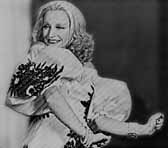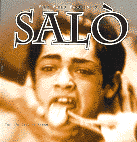
Pier Paolo Pasolini

Pier Paolo Pasolini
Pier Paolo Pasolini's 197_ film based loosely on the collective works of the
Marquis. He masterfully sets the philosophy in Facist Italy near the end of WWII.
I can't believe this wasn't originally included.
It is probably the biggest (maybe not as well known) tribute to Sade's work.
information by saltimbank
Sal� le 120 giornate di Sodoma (1975) is the last film of Pier Paolo Pasolini (Bologna 1922 - Roma 1975). As the same title of the film affirms clearly, it is entirely based on the homonym sadian novel, and it literally quotes sceneries and situations of marquis' masterpiece. The film is structured in four episodes in which the text content of Sade's work is translated in images and dialogues absolutely equivalent to the explicit and raw phrasing which characterizes the incomplete work of the Bastille.
Comparing structures and dialogues of the film with architecture and text of the novel is possible to become account of the perfect correspondence between the last Pasolini's work and the Sade's novel: the "Antinferno" (hard to translate term! Perhaps you can think "ante-hell"), the first one of the four episodes of the film, is based on the "Introduction" of the sadian work; the "Circle of manias" and the "Circle of shit" use both the material of the "First part" of the marquis' 120 days (the only one that Sade brought to conclusion); the "Circle of blood" corresponds to the "Fourth part" of the sadian masterpiece.
Between the characters of Pasolini's work (compare the indications on the staff at the beginning of the film with the list sets at the end of the "Fourth part" of the novel) we find, in perfect harmony with the text of the Bastille: four gentlemen (the masters), four narrators (the narrators), eight masculine victims (the boys), eight female victims (the girls), four daughters (the brides), four soldiers (the principal sexual athletes), four collaborationists (perhaps the subordinate sexual athletes), five panders and maids (secondary characters of the film, perhaps referable to the maidservants of the sadian novel). In the film the four olds don't exist: their roles (for instance the dormitory keeping) are assumed by the four narrators.
 Mrs Vaccari, first narrator of Pasolini's film, talks about the following passions of the sadian novel ("First part"): number 1 and 3 of the day 1, number 5 of the day 2, number 3 of the day 29, number 5 of the day 30. Mrs Maggi, second narrator, narrates the fifth passion of the day 13, the number 2 of the day 20, the number 2 of the day 24, the number 1 of the day 13 and the number 5 of the day 27. Mrs Castelli, narrator of the "Circle of blood", talks about the passion 148 of the "Fourth part" (the episode of Mr. "Hell") quoting the torture of the mouse sewn in the vagina (last page of the sadian novel, paragraph named "additional tortures").
Mrs Vaccari, first narrator of Pasolini's film, talks about the following passions of the sadian novel ("First part"): number 1 and 3 of the day 1, number 5 of the day 2, number 3 of the day 29, number 5 of the day 30. Mrs Maggi, second narrator, narrates the fifth passion of the day 13, the number 2 of the day 20, the number 2 of the day 24, the number 1 of the day 13 and the number 5 of the day 27. Mrs Castelli, narrator of the "Circle of blood", talks about the passion 148 of the "Fourth part" (the episode of Mr. "Hell") quoting the torture of the mouse sewn in the vagina (last page of the sadian novel, paragraph named "additional tortures").
Some events, as well as some link episodes which Sade uses to connect among them the stories of the narrators, find place in varied parts of Pasolini's film: in the "Antinferno" we find the circumstance of the exchange of the daughter-wives (to semplify, Pasolini doesn't speak of the relationship between the Bishop and the Duke's wife), the details about the capture of Franco, one of the masculine victims (Introduction, capture of C�ladon), the details of the capture of Tonino, other masculine victim (Introduction, capture of Adonis), the details of the capture of Albertina, one of the female victims (Introduction, capture of H�b�. But see also, one or two pages before, the reference to the tooth), the details of the capture of Renata, other female victim (Introduction, capture of Sophie), the Duke's sermon to the victims (Introduction, final part of the Rules), the rules of the villa (Introduction, Rules).
In the "Circle of manias" we find the reproach of His Excellency to Mrs Vaccari (first part, the President's reproach to the Duclos, between the second and the third passion of the first day), the dissatisfaction of Monsignor (first part, the Bishop's dissatisfaction, between the second and the third passion of the first day), the Duke's considerations on the repentant criminals (Introduction, portrait of the Duke de Blangis), the masturbation lessons (first part, beginning of the second day), the ejaculation proof (first part, end of the day 29), the marriage of two victims (first part, beginning of the seventh day. But elsewhere too), the Duke's discourse on happiness (first part, end of the day octave).
In the "Circle of shit" Pasolini inserts the episode of the Mrs Maggi's bottom (first part, the friends ask Mrs Duclos to show the bottom, beginning of the eighth day), the discourse of Mrs Maggi that announces she will narrate the history of the President (first part, Mrs Duclos announces that she will narrate the history of Durcet, between the first and the second passion of the day octave), the story of the Duke that kills his own mother and the tears of Renata (first part, the Duke narrates the killing of his own mother and Sophie cries, between the second and the third passion of the second day), the protests of Renata (first part, beginning of the day ninth), the meal of Renata (first part, beginning of the seventeenth day), the way to make the excrements delicious (first part, end of the twentieth day), the President's inspection (first part, beginning of the day 26), the consideration of His Excellency on the breath (first part, beginning of the nineteenth day), the discourse on the fury of the satiated libertine (first part, between the first and the second passion of the tenth day), the appreciations on the bottom of Mrs Maggi's sister (first part, end of the second day), the beauty contest (first part, end of the day 27), considerations of the friends on the bottoms of the beauty contest (first part, between third and the fourth passion of the eighteenth day).
 At last the "Circle of blood" proposes the sapphic loves of Eva and Antinisca (first part, Aline and Zelmire are surprised together in bed, beginning of the day 25) and numerous scenes of torture which I have not brought back yet to as many episodes of the sadian text.
At last the "Circle of blood" proposes the sapphic loves of Eva and Antinisca (first part, Aline and Zelmire are surprised together in bed, beginning of the day 25) and numerous scenes of torture which I have not brought back yet to as many episodes of the sadian text.
As regards the gentlemen, it is clear that in Pasolini's film "Duke" and "Monsignor" are the counterpart of the "Duke de Blangis" and his brother "Bishop of�", while "His Excellency", to the light of the above-mentioned episodes, seems to be the counterpart of the "President de Curval", as "President" seems the counterpart of the "famous Durcet", that Sade first calls collector and then financier.
Everything in the film has not conversed, postpones enough faithfully to the Sade's text of the 120 days: from the authentication of the rule, to the bathroom where the friends effect the more indecent projects; from the capture of the victims, to the urn in which the friends insert the small sheets of paper that manifest their preferences; from the tortures of the circle of blood to the disposition of the environments of the villa.
information by Sisto Garesi(noirceuil@hotmail.com)